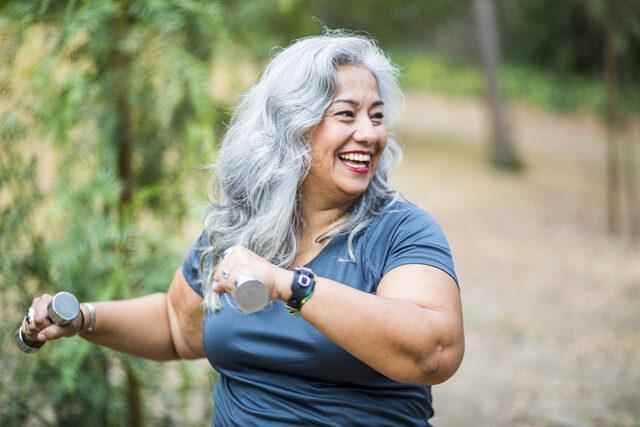In 2019, the European Working Group on Sarcopenia in Elderly People (EWGSOP2) defined sarcopenia as low muscle strength as the first component followed by muscle dysfunction. If low muscle strength is accompanied by low muscle mass, a diagnosis of sarcopenia is made. In elderly individuals, sarcopenia is associated with serious complications such as falls, functional decline, frailty and mortality; It is associated with cognitive impairments, defined as a decrease in one or more cognitive areas such as language, memory, reasoning, social cognition, planning, decision making, and problem solving. Dietitian Busenur Altıkulaç gave information about the subject.
WHAT CAN BE DONE TO PREVENT SARCOPEEN?
Recommendations for the prevention and treatment of sarcopenia due to aging are as follows;
DON’T FORGET TO RENEW BODY PROTEIN STORES
Aging affects skeletal muscles by disrupting the balance between cell renewal and differentiation, and protein synthesis and degradation. Conditions such as decreased mobility with advancing age, decreased appetite, poor oral health, dysphagia, social isolation and socioeconomic conditions increase the breakdown of amino acids in the body protein pool, increasing the loss of muscle mass and causing a progressive decrease in function. Therefore, 0.8-1.2 grams of protein source per your daily body weight should be consumed such as eggs, lean cheese, yoghurt, red meat, chicken, fish.
MAKE SURE YOU ARE NUTRITIONAL SUFFICIENTLY
The mechanisms of the “anorexia of aging” are not fully understood. But low food intake and monotonous diets put older people at risk for inadequate nutrient intake. Therefore, while malnutrition further reduces physical capacity, the decrease in muscle strength and physical ability in advancing age may increase the risk of malnutrition. The interactions between nutrition, aging, and muscle strength are reciprocal. Therefore, do not forget to consume energy-containing foods such as whole grains, bulgur, fruit, legumes for your quality energy intake. Remember that protein consumed in the presence of sufficient energy contributes to muscle synthesis.

PAY ATTENTION TO OBESITY, MAINTAIN YOUR IDEAL WEIGHT
The pathogenic relationship between adipose tissue and muscle is also very important for sarcopenia. Increasing evidence suggests that obesity-associated metabolic factors induce the progression of sarcopenia. The increase in body fat mass in the case of obesity is characterized by increased production of fatty acids, which are not only stored in adipose tissue but can also accumulate in skeletal muscle. As a result of increased fatty acids and oxidant substances in skeletal muscle, there is a decrease in muscle mass, muscle fibers and function.

PAY ATTENTION TO NUTRITIONAL DEFICIENCIES
The nutrients associated with sarcopenia in older adults are vitamin D, protein and carotenoids, selenium, and vitamins E and C. There is also some evidence that long-chain polyunsaturated fatty acids may have significant effects on muscle strength in older people.

GET SUITABLE VITAMIN D
Although the direct effects of vitamin D on normal muscle strength and physical function are controversial, the effect of vitamin D deficiency on myopathy has been mentioned for many years. The potential mechanisms linking vitamin D to muscle function have not been fully elucidated. Most studies have been consistent with the possibility that vitamin D has direct effects on muscle strength. Therefore, make sure your blood vitamin D level is higher than 30 ng/dl.

Consume fish 1-2 times a week
There are studies that show higher grip strength in older men and women who consume more oily fish, one of the richest sources of omega-3s. Therefore, sardines, mackerel, salmon, anchovies, etc., obtained from the clean sea. Prepare and consume oily fish in accordance with healthy cooking methods such as steaming and baking.

PERFORM PHYSICAL ACTIVITIES APPROPRIATE FOR YOUR AGE
Physical activity is an intervention that improves brain function. It has been reported that exercise increases the volume and intensifies the prefrontal cortex, hippocampus, which are neuronal regions related to memory and cognition. Research on people with Alzheimer’s, the most common form of dementia, has shown that exercise can improve cognitive and physical function. It has been shown that a well-designed resistance training program has positive effects on the nervous and muscular systems, increasing muscle mass and muscle strength. In patients diagnosed with sarcopenia, the quality of life can be improved with appropriate exercise and protein-rich nutrition support.

To develop strategies to prevent or delay sarcopenia, a better understanding of lifestyle factors and related mechanisms that affect the rate of decrease in muscle mass and strength in old age is needed. The potential effects of interventions, especially in the early stages of life, should not be forgotten. Optimizing diet and nutrition throughout life may be the way to prevent sarcopenia and increase physical capacity later in life.
